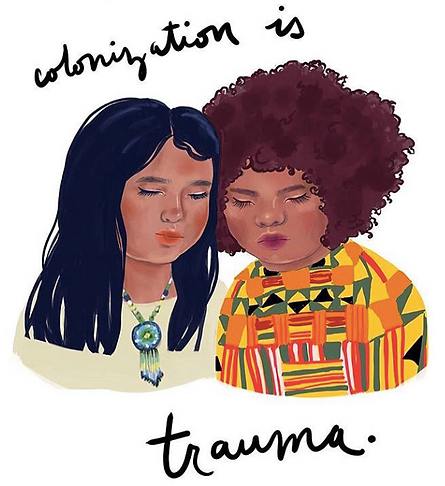
Intergenerational Trauma and Education

The impact of trauma on learning in post-secondary institutions is critical to students' academic success. Recent studies on how Aboriginal people experience mental health issues bring attention to Aboriginal students' experiences of intergenerational trauma (IGT). IGT occurs when the maladaptive effects of an original trauma experience, such as historic trauma inclusive of Indian Residential Schools (IRS), results in unhealthy effects on the first generation being passed down to the next generation or multiple generations (Gaywish & Mordoch, 2018).
Indigenous students have a higher likelihood of experiencing trauma than others, and often, the trauma can be more complex than that experienced by non-Indigenous students. The introduction of Indigenous content and pedagogy responds to the effects of intergenerational trauma (historically and ongoing) in an educational setting (Gaywsh & Mordoch, 2018).
Trauma-informed educational practices can be crucial to promoting and fostering resilience in all children, especially those who might otherwise struggle in class because of trauma. Trauma-informed education helps Indigenous students learn about the effects of colonization on their lives, families, communities, and educational journeys. Listening and responding to Indigenous students' voices is a step forward in the decolonization of educational systems and will eventually contribute to the development of Indigenous scholars and the Indigenous renaissance identified by Battiste (2013).
Why Does Intergenerational Trauma Happen?
-
Behaviours and negative coping strategies are passed on to through modelling
-
Limited ability and/or lack of knowledge and skills to assist their children in coping with difficult situations or emotional difficulties.
-
Limited ability and/or lack of knowledge and skills to support their children in dealing with developmental transitions and milestones.
-
Overprotective or neglectful of children and their needs
The Soul Wounds of the Anishinabek People (Restoule, 2013)
Symptoms Among Indigenous Youths
-
Addictions, alcohol or drug abuse
-
Suicide acts, thoughts and behaviours
-
Internalized sense of inferiority
-
Cultural identity issues
-
Poor attachment to caregivers
-
Abuses: physical, sexual, emotional/psychological, mental, spiritual
-
Depression
-
PTSD
-
Cultural identity issues including denial or refusal of cultural background, cultural identity confusion, fear of learning or practicing culture
Impacts On Learning
A growing body of research indicates that adverse childhood experiences (ACEs) tend to have significant and lasting effects (Shonkoff & Garner, 2012). Symptoms resulting from trauma can directly impact a student's ability to learn, and the continual effects of intergenerational trauma can adversely affect a student's attention, memory, and cognition. In youths, their ability to focus, organize, and process information is also reduced, resulting in feelings of frustration and anxiety. Creating a trauma-informed culture will positively impact academic success not only for Indigenous students but for all students.
While trauma has a negative effect on learning, learning also can undo trauma.
(Terrasi, & de Galarce, 2017)
-
Difficulty focusing, retaining, and recalling
-
The tendency to miss a lot of classes - Absenteeism
-
Challenges with emotional regulation
-
Fear of failure and taking a risk
-
Anxiety - deadlines, exams, group work, or public speaking
-
Anger, helplessness, or dissociation when stressed
-
Learning disabilities with a psychological basis
Source: Hoch et al., 2015

“In Their Own Words” Illustration by Julie Flett
Aboriginal Youths and risk for PTSD
1. Many of the stresses these children are exposed to within their families and communities are linked to and shaped by the experiences of their parents and grandparents who attended residential schools (Bopp et al., 2003).
2. The relationship patterns in Aboriginal communities and families can be traced back to abuses experienced in residential schools (Bopp et al., 2003).
3. Aboriginal youth; grow up in violent households with families facing stressful conditions (Health Canada, 2003).
References
Battiste, M. (2013). Decolonizing education: Nourishing the learning spirit. Saskatoon, SK: Purich.
Bopp, M., Bopp, J., & Lane, P. (2003). Aboriginal Domestic Violence in Canada. Aboriginal Healing
Foundation. https://deslibris.ca/ID/200470
Gaywish, R. and Mordoch, E. (2018) Situating Intergenerational Trauma in the Educational Journey. In Education, 24, 3-23.
Hoch, A ., Stewart, D ., Webb, K ., & Wyandt-Hiebert, M. A . (2015, May). Trauma-informed care on a college campus. Presentation at the annual meeting of the American College Health Association, Orlando, FL.
Shonkoff, J.P., Garner, A.S. (2012). The lifelong effects of early childhood adversity and toxic stress. Pediatrics, 129, 232–246.
Terrasi, S., & de Galarce, P. C. (2017). Trauma and learning in America’s classrooms. Phi Delta
Kappan, 98(6), 35–41. https://doi.org/10.1177/0031721717696